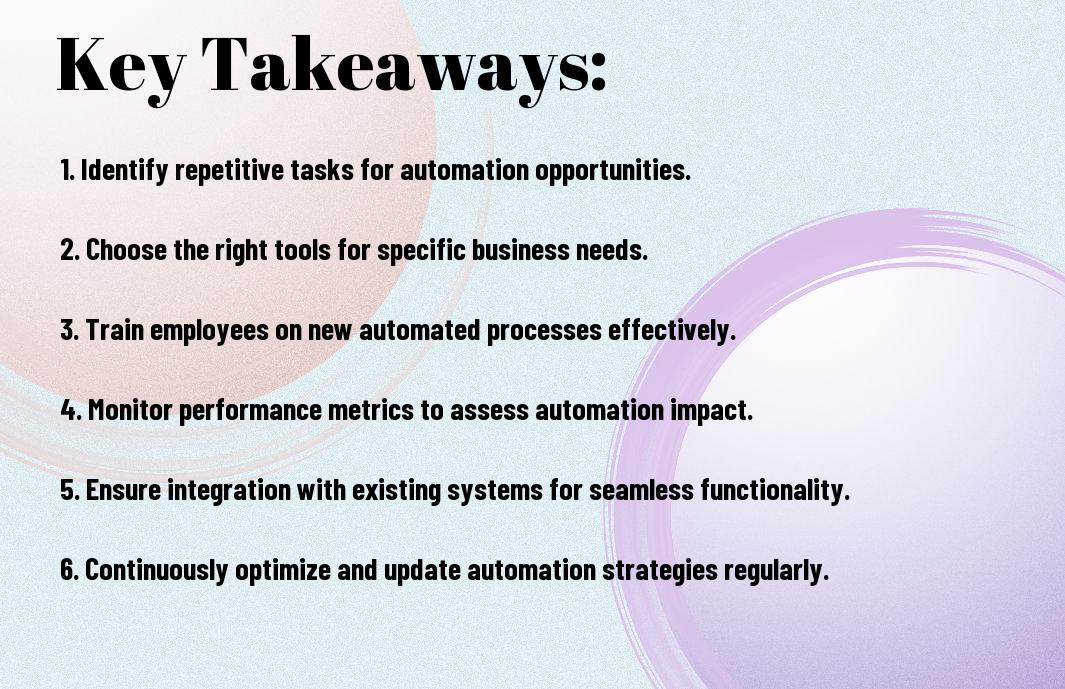It’s time to transform your business operations by leveraging automation effectively. In today’s fast-paced environment, implementing automation can streamline processes, boost productivity, and reduce costs. This post will guide you through actionable tactics that you can immediately apply to enhance your automation strategies, leading to impactful results. By understanding the key components and tools available, you can take decisive steps to create a more efficient and responsive organization.
Key Takeaways:
- Identify repetitive tasks within your organization that can be automated to improve efficiency and reduce human error.
- Invest in user-friendly automation tools that integrate well with existing systems to ensure smooth implementation.
- Foster a culture of innovation by training employees to embrace automation technologies and encouraging feedback on processes.
- Measure the impact of automation on productivity and performance metrics regularly to identify areas for improvement.
- Stay updated on industry trends and advancements in automation technology to continuously enhance business operations.

Understanding Automation
Before venturing into tactical approaches, it’s imperative to grasp the foundational elements of automation. Knowing how automated processes can propel your business forward will set the stage for implementation. For a deeper insight, explore 2025 Business Automation: Invest for Future Success.
Definition and Importance
For businesses today, automation refers to technologies that perform tasks with minimal human intervention, streamlining operations and increasing efficiency. Understanding its importance can lead to enhanced productivity, reduced labor costs, and improved customer satisfaction.
Types of Automation in Business
Automation encompasses various categories that can greatly benefit your operations. These include:
| Type | Description |
| Fixed Automation | Used for high-volume production with rigid processes. |
| Programmable Automation | Allows for reprogramming for different production runs. |
| Flexible Automation | Adapts to changes in volume and product type. |
| Industrial Robotics | Robots that can automate tasks in manufacturing. |
| Intelligent Automation | Leveraging AI for complex decision-making tasks. |
Automation not only streamlines processes but can also enhance your decision-making and allow your team to focus on strategic tasks. Here’s how it impacts your organization:
- Improved operational efficiency.
- Reduction in human error.
- Enhanced scalability for business growth.
- Cost savings over time.
- Greater employee satisfaction with simplified tasks.
Assume that by understanding the various types of automation, you’ll be better equipped to choose the right solutions for your business needs.
Assessment of Current Processes
Now is the time to evaluate your existing processes to identify areas where automation can have a significant impact. By assessing how you currently operate, you can uncover inefficiencies and opportunities for improvement. A thorough examination will allow you to align your automation strategies with specific business goals, ensuring that changes lead to tangible benefits.
Identifying Repetitive Tasks
Between daily operations, you’ll likely find numerous tasks that are repetitive and time-consuming. By pinpointing these activities, such as data entry, invoice processing, or customer follow-ups, you can focus your automation efforts on areas that will save time and resources, ultimately enhancing your business efficiency.
Evaluating Technology Readiness
Beside identifying repetitive tasks, assessing your technological infrastructure is crucial for effective automation. Understanding what tools and software you currently have—and their capacity for integration—will guide your automation initiatives. You must ensure that your existing systems can support new technologies, as this preparedness will determine the success of your automation journey.
Tasks associated with evaluating your technology readiness involve taking stock of your current software and hardware capabilities. Analyze whether your existing tools can handle automation tools, and check for compatibility issues. Be mindful of your team’s technical skills and readiness to adopt new systems. Addressing these factors will pave the way for a seamless transition to automated processes, maximizing the potential of your business operations.

Choosing the Right Tools
Many businesses overlook the importance of selecting the right automation tools for their specific needs. When evaluating options, consider factors like scalability, ease of use, and integration capabilities. Your choice should align with your unique processes and objectives, ensuring optimal efficiency and enhancing your overall productivity.
Software Solutions for Automation
Across various industries, numerous software solutions can streamline operations and enhance productivity. From project management tools to customer relationship management software, the right solution can simplify tasks and improve communication. Explore options that specifically address your business processes to maximize their effectiveness.
Integrating with Existing Systems
Along with selecting the right tools, successful automation requires seamless integration with your current systems. Compatibility minimizes disruptions and maintains workflow continuity, ensuring that you don’t experience unnecessary downtime as you transition to automated processes.
For instance, if you use a specific accounting software, look for automation tools that easily connect and share data with it. This integration enables you to automate invoicing and expense tracking without altering your established processes, thus preserving valuable time and resources. By aligning your new tools with existing systems, you can create a cohesive technological environment that fosters efficiency and supports your overall business growth.

Implementing Automation Tactics
Once again, embracing effective automation tactics can dramatically improve your business operations and boost productivity. By strategically implementing these approaches, you can streamline processes, reduce errors, and free up valuable time for your team to focus on strategic initiatives. The following steps will guide you through the implementation phase and help you maximize the benefits of automation.
Step-by-Step Implementation
The following table outlines a structured approach to implementing automation in your business:
| Step | Description |
| 1. Identify Processes | Examine workflows to identify repetitive tasks suitable for automation. |
| 2. Select Tools | Choose appropriate automation tools that align with your identified needs. |
| 3. Create a Plan | Develop a clear implementation plan outlining timelines and responsibilities. |
| 4. Test Automation | Run pilot tests to identify issues and make improvements before full deployment. |
| 5. Monitor and Adjust | Continuously track performance and adjust automation strategies as needed. |
Employee Training and Engagement
Employee engagement is vital to the success of your automation initiatives. You need to ensure that your team understands the new systems and feels empowered to leverage them effectively.
Automation introduces new tools and processes, which can create a sense of uncertainty among employees. To mitigate this, you should invest in comprehensive training programs that not only provide the necessary skills but also foster a culture of innovation and adaptability. Engaging your employees in the automation process will create buy-in and help them see the value in incorporating these changes into their daily routines.
Measuring Impact and Efficiency
Unlike traditional methods that rely heavily on intuition, measuring the impact and efficiency of your automation efforts demands concrete metrics. Implementing a systematic approach to evaluate performance will not only help you identify areas of improvement but also align automation initiatives with your business goals. By closely monitoring these indicators, you can make informed decisions that drive sustainable growth and ensure that your automation strategies are delivering the intended results.
Key Performance Indicators
About tracking your Key Performance Indicators (KPIs), focusing on relevant metrics is important for assessing the effectiveness of your automation systems. These KPIs could include time saved, error rates, and overall productivity improvements. By analyzing these figures, you can identify the strengths and weaknesses of your automated processes, allowing you to make informed adjustments to enhance efficiency further.
Continuous Improvement Strategies
Beside tracking performance metrics, adopting continuous improvement strategies will keep your automation initiatives aligned with your evolving business needs. This involves regularly gathering feedback and analyzing data to inform refinements in your processes. By instilling a culture of agility and openness to change, you can maintain high operational standards and consistently enhance the effectiveness of your automation systems.
Performance metrics should be more than just data points; they should serve as the foundation for your continuous improvement efforts. Regularly reassessing your KPIs against your business objectives enables you to pivot as necessary. Creating a feedback loop with your team not only empowers them but also fosters an environment where innovation thrives. The insights you gain will be invaluable as you fine-tune your automation strategies, ensuring they grow along with your business landscape.
Overcoming Challenges
Your journey toward automation can be obstructed by various challenges. Identifying these hurdles early on allows you to implement effective solutions that streamline the process. By understanding common pitfalls and how to address them, you can enhance your automation strategy, ensuring it aligns with your business goals and propels you toward success.
Common Pitfalls in Automation
Pitfalls such as lack of clarity on objectives, inadequate training, or poor technology integration can derail your automation efforts. Failing to address these issues may lead to frustration among your team and could diminish the operational efficiency you’re trying to achieve. Recognizing these pitfalls and being proactive can significantly enhance your automation outcomes.
Strategies for Successful Adoption
An effective strategy for adopting automation involves careful planning, continuous training, and engaging your team throughout the process. Start by setting clear goals for what you want your automation to achieve. Provide your staff with the necessary resources and training to help them adapt, and ensure they understand the benefits that automation brings to their daily tasks.
At the heart of successful adoption is ongoing communication and feedback. As you implement automation tools, invite your team to share their experiences and suggestions. This not only fosters a sense of ownership but also helps you identify areas for improvement. Providing support during the transition phase will allow you to refine processes, making automation a valuable asset that enhances productivity and team satisfaction in the long run.
Summing up
To wrap up, enhancing automation in your business can lead to significant improvements in efficiency and growth. By implementing actionable tactics like identifying repetitive tasks, investing in the right tools, and continuously assessing your processes, you can optimize operations effectively. For further insights, explore How Automation Drives Business Growth and Efficiency. Embrace these strategies to ensure your business remains competitive in a rapidly evolving landscape.
FAQ
Q: What does Enhance Automation in Business entail?
A: Enhance Automation in Business refers to the strategies and practices that businesses employ to integrate automated systems into their operations. This approach aims to streamline processes, reduce manual labor, and increase overall efficiency.
Q: What are some actionable tactics for enhancing automation?
A: Actionable tactics include assessing current workflows to identify bottlenecks, integrating automation tools such as workflow management software, utilizing robotic process automation (RPA) for repetitive tasks, and continuously analyzing data to adapt automation strategies.
Q: How can automation impact employee productivity?
A: Automation can significantly boost employee productivity by allowing staff to focus on higher-value tasks rather than time-consuming manual operations. This shift not only enhances job satisfaction but also encourages innovation within teams.
Q: What types of tools are best suited for business automation?
A: Tools that are commonly used for business automation include CRM software for managing customer relations, project management tools for task tracking, RPA software for automating repetitive tasks, and data analytics platforms for making informed decisions based on real-time insights.
Q: How can a company measure the effectiveness of its automation efforts?
A: Companies can measure the effectiveness of their automation initiatives through key performance indicators (KPIs) such as reduction in task completion time, increase in overall productivity, cost savings, and improvements in customer satisfaction scores.
Q: What challenges might businesses encounter while implementing automation?
A: Challenges can include resistance to change from employees, the initial cost of implementing automated solutions, the need for employee training, and ensuring that systems are properly integrated with existing processes to avoid disruptions.
Q: How do I get started with enhancing automation in my business?
A: To get started, begin by evaluating your current processes to pinpoint areas for improvement. Research available automation tools that fit your industry, set clear objectives for what you wish to achieve, and create a phased implementation plan to introduce automation gradually while training your workforce.


